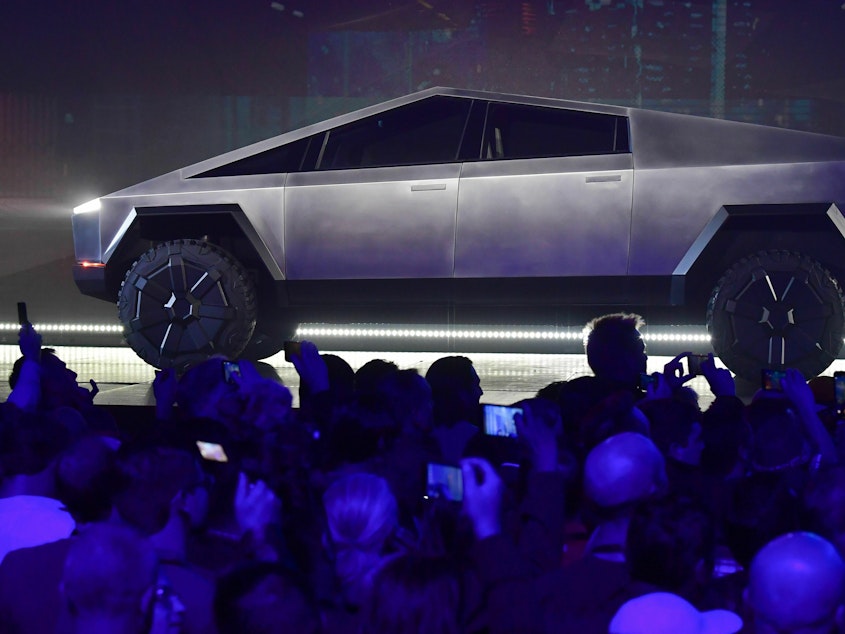After a 2-year delay, deliveries of Tesla's Cybertruck are scheduled to start Thursday

Tesla plans to begin deliveries of its Cybertruck on Thursday, marking the electric automaker's long-awaited entry into the pickup market.
It's been four years since CEO Elon Musk first revealed the Cybertruck's polarizing, polygonal design and two years since Tesla failed to meet its initial delivery target.
Now, the company says a handful of buyers will get to drive away with the first few trucks at an event in Austin, Texas, set for 3 p.m. ET.
Hundreds of thousands of people have placed $100 refundable deposits on the pickups, the company says, but it's anyone's guess how many of those deposits will translate into real sales — or how many trucks Tesla has actually produced.
During an October earnings call, Musk said he wanted to "temper expectations" for how quickly production could ramp up and acknowledged that it could be 18 months before the Cybertruck contributes any significant cash flow.
Sponsored
Tesla originally placed the starting price for the vehicle at $39,900. But that was before it had fully worked out the logistics of mass-manufacturing the Cybertruck's challenging design.
The body is full of sharp lines and straight edges, a wedge-like look that one designer likened to "origami." Its windows, originally described as "armor glass," proved breakable during an embarrassing on-stage test.
And the truck's exterior is made of a stainless steel alloy, the same material that Musk's engineers used for SpaceX's Starship rocket.
That unusual material choice, paired with the aggressively angular design, has caused countless production woes. Every minor inconsistency shows up glaringly; without precise manufacturing instruments, the finished product comes out looking wobbly, Fast Company reported.
The truck has also been plagued by "serious powertrain, braking, suspension, structural, and sealing issues" plus months of pandemic-related supply chain slowdowns, according to Motor Trend. Cybertruck deliveries were slated to start in 2021, which would've made Tesla a pioneer in the electric pickup market.
Sponsored
Instead, the company's competitors charged ahead. Rivian started sales of the R1T in 2021. Ford began selling the F-150 Lightning in 2022. And GM began selling an electric version of its Silverado in limited numbers earlier this year.
These other electric pickups are seeing mixed success in the market. Rivian, for example, says its sales are doing better than expected. But sales of Ford's F150 lightning fell 46% in the third quarter.
Interest in electric pickups continues to rise, but with a high price tag and concerns over the availability of charging stations, many consumers say they're waiting to buy.
And when it comes to trucks, they may be more likely to buy from brands they already drive. A survey from Cox Automotive found that the Cybertruck ranked lowest in shopper consideration of electric pickups — and interest in the Cybertruck dropped slightly when the brand was revealed to shoppers.
Tesla is still broadcasting confidence that its truck can compete, with Musk saying the pickup is "radical," "special" and "an amazing product."
Sponsored
The Cybertruck has six seats and a cargo bed (or "vault," as Tesla calls it) that's 6 1/2 feet long. Its tailgate also hides a ramp for rolling materials or vehicles into the bed.
Tesla lists its maximum range at more than 500 miles, but the truck will be offered in a wide spectrum of driving range and weight capacity, depending on which motor is powering the vehicle.
While the basic single-motor truck would have a range of around 250 miles and a tow rating of 7,500 pounds using rear-wheel drive, the three-motor all-wheel-drive version would double that range and be capable of towing 14,000 pounds, Tesla says.
Still, Tesla may have a long road ahead when it comes to proving that the Cybertruck is as rugged as the rest of the pack. The one-piece body may restrict the installation of specialized toolboxes, ladder racks or platforms that some business fleet owners rely on.
Some aspects of the Cybertruck design remain a mystery altogether.
Sponsored
Tesla has yet to announce, for example, whether the model will have power outlets for using tools or whether it could mimic the survival promise of its rival, the Ford F-150 Lightning, in serving as a backup generator for homes.
And tech writers at the Verge have been collectively puzzled by a jumbo-sized windshield wiper that may or may not actually clear the glass.
NPR's Fernando Alfonso III and Bill Chappell contributed reporting. [Copyright 2023 NPR]


